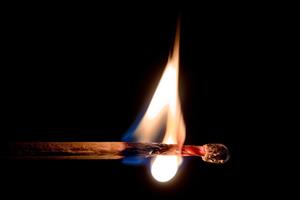PDF chapter test TRY NOW
The chemical process in which substances burn in the presence of oxygen to liberate energy in the form of heat is called combustion.
Combustion is commonly called burning. The substance that burns is called fuel, oxygen is called an oxidizer and the new substance formed is known as exhaust.
\(\Delta\)
For combustion to occur, external factors are required, such as light, heat, oxygen and so on. The substance that takes place in this reaction is classified as combustible (that is any material which burns in the presence of oxygen is called as combustible or flammable materials). They are also called as fuels.
The combustion process breaks off when the total heat energy of products and reactions are equalised. Combustion is an example of an exothermic reaction. The term exothermic refers to the liberation of heat into the surroundings.
Combustible substances: The substance which burns in presence of oxygen is called a combustible substances for example, LPG, Petrol, etc.
Non-combustible substances : The substance that does not burn in the presence of oxygen is called a non-combustible substances for example, water, sand, etc.

Combustible substances
The lowest temperature at which any substance catches fire is called its ignition temperature.
If the temperature of combustible material is lower than its ignition temperature, it does not catch fire. For example, petrol at room temperature does not catch fire because its ignition temperature is higher than room temperature.
When the ignition temperature is low, the substance catches fire easily with a spark or other external source. For example, inflammable substances are petrol, diesel, natural gas, LPG, etc.
Fact:
We know that match sticks burns only when it is rubbed on the hard side given as we know friction produces heat. This occurs because the ignition temperature of the chemical present in the match stick is higher than the room temperature. The chemical present in the head of the match stick ispotassium chlorate mixed with sulfur and the hard side surface is red phosphorous.
In ancient days, pinewood was used in creating match stick which was dipped in sulphur. A mixture of antimoney of tri-sulphide, potassium chloratewith white phosphorous was used, which was dangerous for the worker involved in manufaturing matchsticks (white phosphorous is dangerous as it is leat stable and more stale reactive).
